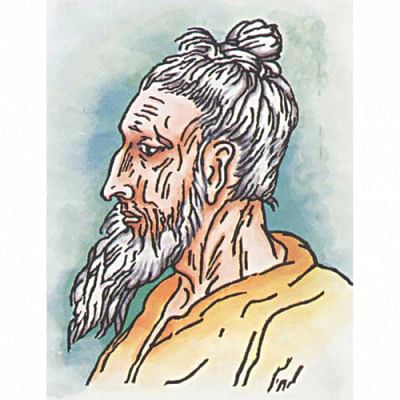Fakir Lalon Shah: Love, life and liberation

One cannot decisively introduce—much less sum up—the life and work of Fakir Lalon Shah (c. 1772-1890). An extraordinary figure known for orally composing thousands of songs in Bengali—one who had no formal education and came from the poor peasant class—Lalon is variously celebrated, canonised, even commodified and corporatised in Bangladesh today. He has many disciples and numerous listeners and admirers in both rural and urban areas in the country.
But we do not know exactly when and how and where Lalon was born. Yet a place called Chheunriya, near the town of Kushtia in Bangladesh, remained the consistent site of Lalon's life-practices at a conjuncture when Bengal was colonised by the British. And today it is widely known that Lalon died on October 17, 1890 (the Bengali date is Kartik 01, 1297). Following his death, the November 1890 issue of the Hitakari magazine—published from Kushtia—maintained that it was difficult to find biographical material on Lalon, and that both he and his disciples remained silent surrounding the questions of his birth and even his overall identity.
And, indeed, that silence is not by any means pointless. That silence rather bespeaks Lalon's radical opposition to—and even his deeply emancipatory predilection for abolishing—all forms and forces of identity politics which deepen oppression predicated on caste, religion, class, and gender. Yet we continue to find many "communally" motivated, speculative, and sectarian accounts of Lalon's birth and identity. Of course, Lalon was not a political activist in the contemporary sense. Contrary to popular characterisations, Lalon was not even a Baul, as he never identified himself as one, nor was he a Sufi in the strictest sense. Nor was he a metaphysician or a mystic or a spiritual guru or even a musician in the Western sense of the terms. He was a Faqir in whose musical universe—rooted as it was in his class and community—the poetic and the philosophical and the political profoundly intersect in the interest of love, liberation and life.
Further, Lalon belongs to a homegrown tradition of sadhana—an indigenous constellation of rich and rigorous practices that combine the elements of Buddhist, Hindu, Islamic, and Jainist traditions. As I argued elsewhere, Lalon's songs and practices embody and enact deep interactions among certain aspects of the Buddhist Shahajiya path, Guadia Vaishnavism, and even the Kartabhaja, while, however, Lalon resists and ranges beyond either eclectic epistemological zodiacs or syncretic closures as such.
Speaking of the homegrown tradition of practices, then, it is customary in certain circles to invoke such radical figures as Kabir (a 15th century saint-poet), Chandidas (a medieval poet of Bengal), Nanak (the founder of Sikhism), and even Tukaram (a 17th century Marathi poet) as the philosophical predecessors of Fakir Lalon Shah. One may trace certain intriguing and even instructive correspondences among them. Yet Lalon is strikingly and constitutively different from his so-called precursors.
In fact, to make sense of Lalon's work, it is important that we pay attention to the Nadia (now a district in West Bengal, India) school of thought—a social and oppositional movement in its own right—represented by a trinity of radical 15th century figures like Chaitanya (1486-1534), Nityananda (1474-1540), and Advaita Acharya (1434-1559), ones who denounced the caste system and other forms of discrimination. This movement gathered remarkable momentum throughout Bengal during the reign of Alauddin Hussain Shah, whose conception of Islam was resonant with the movement itself. It is also significant that Vijay Gupta—who wrote his Manasamangal Kavya during the reign of Sultan Alauddin Hussain Shah—compared the Sultan to Arjuna himself.
In any event, Lalon—in his songs—alludes to those three figures as "tin pagols," while underlining his deep connections to them. But Lalon carves out his own distinctive space and arguably represents the height of the tin-pagol tradition in colonial Bengal by way of pointing out—in the spaces of his own songs—the constitutive contradictions and even inherent inconsistencies of oppressive structures and systems like casteism, communalism, and even patriarchy. Lalon, for instance, is famous for raising the question: "If a Brahmin male/ Is known by the thread he wears, / How is a woman known?" and for this question: "A Muslim is marked by the sign/ Of circumcision; but how should you / Mark a woman?" (all translations in this piece are mine). Lalon's interventionist and emancipatory interrogations made him a genuine predecessor to the revolutionary poet Kazi Nazrul Islam while Rabindranath Tagore admired and promoted Lalon's work in different contexts. The American Beat and radical Buddhist poet Allen Ginsberg was even "influenced" by Lalon, although Ginsberg ended up exoticising and even Orientalising Lalon.
Space limits here do not permit me to dwell on the entire range of influences Lalon exercises, nor do they allow me to zoom in on the complexities of his relationships with the Nadia movement as such. But I intend to touch on a few more issues that seem generally unheeded. True, Lalon was a Faqir—one who produced the kind of music that creatively and even unprecedentedly theorises becoming and being. For instance, Lalon theorises the koron which may be taken as sadhana-as-practice and the param that represents the "Divine" Subject realised in the unity and even indivisibility of the body and the being, imbricated as they all are in the materiality of the here-and-now. I think it is crucial to emphasise that theorising itself remains integral and even organic to Lalon's work, challenging the superficially aestheticist dogma that theory and creativity are incompatible or mutually exclusive.
Lalon even uses the word tattva (theory) directly in his songs. And he is arguably one of the most radical theorists Bengal ever produced—one who advances at least three distinct but interconnected theories in his songs: the theory of the body (dehatattva), the theory of the self (atmatattva), and even the theory of language (bhashatattva). For him, of course, the body constitutes the concrete site of the production of the truth which is the One—the embodied One. Running counter to the Western or Cartesian tradition of the mind/body split on the one hand, and, on the other, to the old tantric traditions in India that characteristically deemed the body to be a means to an end, Lalon conceives of the Body as a totality unto itself—one in which, to use Lalon's own words, "everything resides" ("sobkichhu roy"), including the "adhora" (one that is symbolically or otherwise unrepresentable, one that is more than the Kantian Ding an sich or the unknowable thing-in-itself).
To put it simply, for Lalon, then, to know the body is to know the self and nature and even the universe, while the self itself is constituted corporeally, dissolving the borders between the subject and the object, while enacting the embodied One. In one of his mathematically inspired songs, Lalon ardently asserts: "At the end, the One remains." And the One is not minus the many but with the many. Now Lalon views language as a bodily and spatial and social phenomenon all at once, while also calling attention to its limits and the power of silence. In all this, though, Lalon does not subscribe to any brand of transcendentalism, nor does he endorse any epistemological certitude or closure in the Western tradition. Finally, a word about Lalon's version of "humanism," which I think is more than anthropocentric humanism as such, given that Lalon's embodied One encompasses not only human beings but also all living beings and life-forms—the entirety of Nature. And, indeed, honouring the legacy of Lalon today is to unsettle and even combat and destroy all those oppressive structures and systems like capitalism and colonialism that continue to hurt the integrity of nature, humanity, and the body, to say the least.
Azfar Hussain is currently Interim Director of the Graduate Program in Social Innovation and Associate Professor of Integrative, Religious, and Intercultural Studies at Grand Valley State University in Michigan while he is also Vice-President of the Global Center for Advanced Studies (GCAS), New York, USA.

 For all latest news, follow The Daily Star's Google News channel.
For all latest news, follow The Daily Star's Google News channel. 



Comments